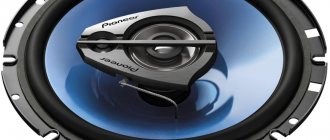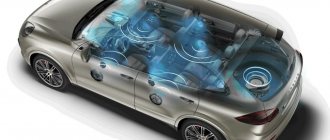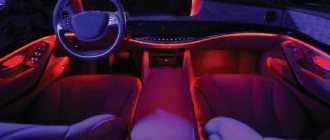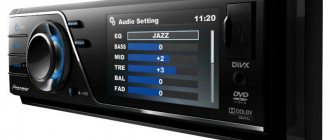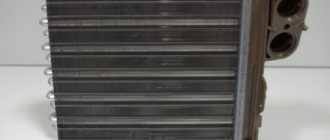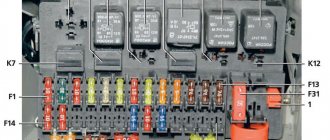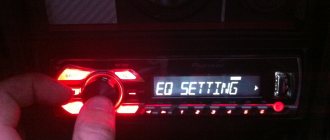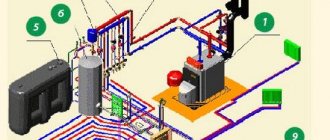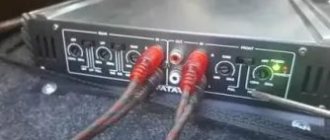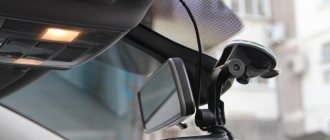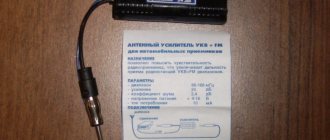Modern car speaker systems are capable of providing high quality sound. However, this is not enough for true music lovers. After all, these people are used to listening to “live” music and are not ready to make compromises.
Fortunately, there is a way by which you can turn a cramped car interior into a concert hall or music salon. We are talking about horn acoustic systems that create a so-called presence effect while listening to audio recordings, which will satisfy the aesthetic needs of the most demanding listener.
Instructions on how to connect a horn to a car
A high-quality sound reproduction system that allows you to create the effect of presence - horn acoustics. Such systems are installed both as home acoustics and in cars, allowing you to create the atmosphere of a large concert hall in a limited space and convey the emotions of the performer to the listeners. How to properly connect a speaker to a car?
Horn acoustics
Pros and cons of horn acoustics in cars
In fact, horn acoustics appeared at the beginning of the last century, when city streets were decorated with poles with bulky loudspeakers. However, with the advent of audio systems similar to modern radio tape recorders, they began to forget about horn acoustics. After all, this option was more suitable for dubbing in large spaces, and not for individual listening to music.
All other music lovers continued to choose traditional speaker systems, as manufacturers of this equipment kept pace with progress and constantly surprised their customers with the development of new media that used the latest technologies for amplification and sound processing.
However, time passed, and the sound of traditional audio systems could not replace “live” music. Therefore, horn acoustics are currently experiencing their rebirth, and the popularity of these acoustic systems is constantly increasing.
This shouldn't be surprising. After all, horns provide traditional acoustic systems with a number of advantages, including:
- high sensitivity allows the listener to “feel” the performer’s emotions;
- "live sound;
- dynamic sound;
- the ability to accurately reproduce high, mid and low frequencies.
Horn audio systems also have disadvantages, the most important of which is price. After all, high-quality horn acoustics are made from expensive materials and, by definition, cannot be cheap. In addition, horn audio systems, capable of reproducing low frequencies at the highest level, can be quite bulky.
Therefore, cars often use compact models to reproduce high frequencies in the range from 2000 to 20,000 Hz. Such horns are called tweeters and are used in conjunction with standard car speakers.
Purpose
In most cases, horn acoustics are designed to reproduce mid and high frequencies, allowing you to improve existing acoustics. The best effect is achieved when used with a subwoofer (amplifier) that reproduces low frequencies.
By adding and changing audio system components, you can achieve the desired sound in your car, and horns are excellent equipment to improve the quality of music in your car.
One popular place to connect horns is at the front of the car. The horns are installed frontally on the housing wall. A waveguide is formed inside with a hole facing outwards.
Another popular option is to connect horns to a system with a low-frequency amplifier, high-frequency and mid-range speakers. All of them are placed in a special case separately from each other, and allow you to achieve better sound.
To properly connect the horn to the radio, you need to use a capacitor. It is also recommended to carry out sound adjustments to properly distribute the sound and achieve maximum immersion.
Other Features
Today, the most common tweeter option is the electrodynamic system. Structurally, it consists of a housing, a magnet, a coil with a winding, a diaphragm with a membrane, and power wires with terminals. When a signal is applied, current flows in the coil and an electromagnetic field is formed. It interacts with the magnet, mechanical vibrations occur, which are transmitted to the diaphragm. The latter creates acoustic waves, and sound is heard. To increase the efficiency of sound reproduction, the membrane has a specific dome shape.
Car tweeters typically use silk membranes. To obtain additional rigidity, the membrane is impregnated with a special compound. Silk is characterized by its ability to more effectively cope with high loads, temperature changes and dampness.
In the most expensive tweeters, the membrane is made of thin aluminum or titanium. This can only be found on very prestigious speaker systems. They are found quite rarely in a typical car audio system. The cheapest option is a paper membrane.
In addition to the fact that the sound is worse than in the two previous cases, such equipment has an extremely short service life. And this is not surprising, since paper cannot ensure high-quality tweeter performance in conditions of low temperature, high humidity and high load. When the car increases engine speed, an unusual sound may be felt.
Don't forget that you can also set up the tweeter using the radio. Even the cheapest models have the ability to adjust the high frequencies. In particular, mid-price models have a built-in equalizer, which greatly simplifies the task.
After installing the tweeter, you need to configure the audio system, and how to do this, read the article “How to configure a radio.”
Installation
How to install and connect a horn without an amplifier directly to the radio? The first step is to make or purchase a podium for the speakers.
In most cases, the podium is supplied with the column, but in some cases you need to make it yourself. This does not require special knowledge, and it is enough to simply measure the dimensions of the speaker and cut a podium to fit these dimensions. When you lack knowledge or tools, it is recommended to contact a specialist.
Horns are installed in two ways:
The options are equivalent to each other and when choosing, you need to rely only on the layout of the car’s interior and audio system. It is recommended to try two variations, and only after that make a final choice.
Diagonal horn placement
The installation location depends on the location of the audio system, and in most cases, it is selected individually for each speaker.
What are tweeters and why are they needed?
To achieve the best effect, tweeter acoustics are installed together with a subwoofer, i.e. amplifier that reproduces low frequencies. It is not advisable to use such speakers separately from others. They are part of the acoustics system. Thus, horns are needed not as the main source of sound, but as auxiliary elements necessary to improve the quality of reproduction.
Connection
Installing additional equipment and making podiums is half the battle. Installed devices need to be connected. How to connect a horn through a standard radio or speakers?
When the connection is made directly to the radio (without an amplifier), you need to use a capacitor, which is a filter for certain frequencies. It allows you to increase the life of the speakers, but its capabilities are limited. When purchasing new equipment, the capacitor is included in the kit, but if it is not there, you need to select and purchase it yourself. The horns are connected directly to the terminals of the radio, but a capacitor must be installed on the plus.
You can connect the horn to the speakers in the same way as conventional speakers. The plus is connected to the positive wire (via a capacitor), and the minus is connected to the negative.
You can connect the horn to the amplifier according to the principle of conventional speakers, and there are no differences in connection. The amplifier itself is installed according to the diagrams specified in the equipment instructions. In most cases, the connection is made with special wires (interconnect) to the radio, and then power wires (power) are connected. After this, connect the speaker wires to the speakers or subwoofer, observing the polarity.
Another type of connection is through a crossover. This is a device for separating a signal by frequency. It is most often made in the form of a separate unit and is perfect for connecting a multi-component audio system.
When connecting, you must comply with all safety requirements.
Installation rules
When installing additional or new speakers, you must follow a number of rules that will help improve sound quality and eliminate the possibility of short circuits:
By following the rules described above, you can achieve the highest sound quality and protect the wiring from short circuits.
Bottom line: you can install horns in your car yourself. But if you have doubts about your own abilities or do not have the special knowledge required for installation, it is recommended to contact specialized auto repair shops so that the car owner is completely confident that the installation is correct and the sound meets all expectations.
Source
Which ones are better to choose?
There are a number of parameters that you should pay attention to when choosing a device. These include:
- availability of necessary exits;
- power;
- nature of the coating.
The sound quality depends on the type of material from which the horn is made. Silk horn tweeters are considered the best. Many brands use silk because... It is soft, so the sound is not fully transmitted. In addition, this material has a high degree of viscosity, which creates pronounced internal friction.
Moreover, in most models of such speakers, silk is treated with special substances that not only improve sound quality, but also increase the moisture and dust resistance of the device. Some companies produce good horns made from artificial materials that sound no worse than instruments made from natural silk.
There must be a connector for connecting a subwoofer. The power of the device must be at least 50W. This will be enough to ensure volume. It is better to purchase devices with high sensitivity.
Theory. Connection types
In electrical engineering there are two types of connections - series and parallel. With a series connection, the resistance is summed up; with a parallel connection, it becomes lower than the smallest of the connected ones. This is something worth remembering and will come in handy in order to connect your speakers correctly.
Basic formulas for parallel and serial connections
There is also a mixed connection. This is when serial chains and parallel connections are “mixed”. In this case, calculation formulas are used, gradually arriving at one of the “pure” circuits - parallel or sequential.
Mixed compound and its conversion to "simple"
The figure shows the sequential transformation of a complex mixed connection into a simple one.
Sound settings
You can connect the amplifier to the car radio yourself. After installing all the elements, you need to configure the system as follows:
The above settings allow you to achieve the best sound of the created system. If the amplifier is part of the radio, then the setup is carried out through the built-in functions of the device.
When installing a speaker system, laying the cable, you should choose the shortest path; it is not recommended to create a large number of connections, since they significantly reduce the reliability of the system.
How to connect
If you expect to be told to connect only in parallel or only in series, you are in vain. The connection diagram is selected individually. There are two main points to take into account:
Implementation of parallel connection
If you have an amplifier of a certain power and there are speakers suitable for it, this is good. But it happens that for the amplifier you need to select a load from several available speakers of different power. This is where you need to understand how to connect speakers in series, parallel or mixed so as not to exceed the parameters.
How to connect speakers - in series or in parallel? And so and so. Depends on what speakers you have. Or rather, with what power and resistance. What is also important is the output power of the channel and how many speakers you want to “hang” on each channel.
Determine the power and resistance of the speakers
It’s quite simple here, but we’ll still give a few examples. These markings are usually marked on the back of the case or basket. The photo shows the parameters of the speakers.
Designation of power and resistance on the speaker
Typically, long-term power is indicated, that is, the value at which the dynamic head is able to operate for a long time. At the same time, MAX POWER is indicated on the ALPHARD head - maximum power. This is peak power, its speaker can withstand, for example, a second.
On old domestic speakers the designations are slightly different. For example, in the figure below 2GDSH-3.
Designations on Soviet speakers
The first digit indicates the power of the product. Further, the head is dynamic broadband and its resistance is 8 ohms. So, we’ve sorted out some parameters, let’s move on.
Correct speaker connections
The peculiarity of connecting speakers is that they have positive and negative inputs. They need to be somehow connected to the inputs of the amplifier, and also somehow connected to each other.
Proper parallel and series connection of speakers
Selecting a mounting height
It is the tweeters that are a headache, even for experienced installers. These little speakers not only need to be placed in the right place, but also at the right angle in order for the scene to form correctly. Larger low-frequency speakers are always installed in one place - these are doors. Even component speaker manufacturers can't determine exactly where the tweeter will play best. Therefore, several types of fasteners are included in the kit. A popular option is the "cup". It is designed for installing a tweeter in a car either on a rack or on a dashboard. The kit may also include a housing for installation on a surface. The most expensive tweeter options can rotate inside the housing for more precise directionality.
The main reason why so much attention is paid to installation in a car is its purpose. The fact is that tweeters are one of the most important components for creating high-quality sound in a car.
This is especially important if the system consists of two components. In this case, setting the sound stage directly depends on the HF
As for three-way systems, there are even more big problems here, because a midrange link is added. It is much larger and requires a closed volume.
No technician will be able to tell you where exactly in your case you need to install the beepers. Therefore, you need to look for a place for installation from scratch. To determine the correct location, you need to use high-quality recordings on which a monotonous voice is recorded. Most often in practice, a test disk is used for testing. It contains special entries that allow you to select the correct location for tweeters.
First you need to set the height of the stage, which means determining the height of the tweeters. If the tweeter is set too high, there will be mismatch with the mid/bass speakers. The closer they are, the easier it is to get them to play together. If the tweeter is installed too low, this will negatively affect the height of the music stage.
Connect 4 channel amplifier to 1 subwoofer
Some car enthusiasts install two loudspeakers in a closed box or bass reflex to get powerful and rich bass. Connecting a subwoofer to a 4-channel amplifier is done using a bridge circuit, but each two channels will work as a bridge to their own speaker. It will no longer be possible to connect other speaker systems, but the bass will be exceptionally strong and dense. To organize sound in the car interior, you will need a separate low-frequency unit. The connection diagram for one subwoofer for 4 channels is made with a thick acoustic cable in compliance with all reliability requirements. It is best to lay the cable in a corrugated plastic sleeve. The plastic material used to make the hoses does not support combustion so that in the event of a short circuit, fire can be avoided. It is important to secure cable lines with ties to avoid breakage in case of strong vibration.
Application
Loudspeakers are widely used in various walks of life. They are used in everyday life, in cultural and sporting events of various sizes (for loud music or start announcements), in transport and in industry. Currently, loudspeakers are widely used in the security field. Thus, these devices are used to notify people about fire and other emergencies.
Loudspeakers are often used to convey advertising information to people. In this case, they are installed in crowded places, for example, in squares, shopping centers, and parks.
Daisy chaining of speakers
A daisy chain connection is when they are switched on one after the other, like carriages. If you look at the diagram, the wires are connected like this. We feed the minus from the output of the amplifier to the minus of speakers A, and the plus to the plus of loudspeaker B. And we connect their free inputs (plus at A and minus at B) to each other.
Connecting speakers in series: resistance adds up, output power drops
Please note that the impedance of the speaker chain increases. It is summed up from all components. In the example, two 2 Ohm speakers are connected in series. The total resistance is already 4 Ohms. This connection is good if the amplifier cannot operate with a low-impedance load. Low resistance is 2 ohms and below. In this case, either speakers with a higher resistance are connected, or low-impedance ones are connected in series.
How to connect three or more speakers in series
How to connect three speakers in series to one channel? Yes, everything is the same - one by one. Minus, apply to minus first (A); plus - to the plus of the third C (or last). We connect the free plus from element A to the minus of element B. Then we feed plus B to minus C. So we get a chain of three speakers connected to one channel.
How to connect 3 speakers to 1 channel in series
If you need to connect four or more fragments in series to one channel, simply insert them in the middle. Don't forget that circuit resistance adds up. With each new element in the chain it becomes larger.
Power in series connection
As the resistance increases, the output power will drop. How many watts will each speaker receive when connected in series? And you can count. There is a formula - it is in the picture.
Input power is the power that the amplifier will put into the channel, that is, what we are trying to calculate. The measured power is that indicated in the characteristics (what goes into the channel according to the passport data). And Zr is the resistance at which the power was measured. It is usually written in the characteristics as the minimum load on the channel. And the total resistance is the resistance of the speakers that you plan to “hang” on this channel.
Formula for calculating the actual power supplied to the amplifier channel
Let's apply the formula with an example. Let us have a 2-channel amplifier that outputs 100 W (2*100 W) to each channel. It cannot work with low-resistance loads (2 Ohms and below). Therefore, it was decided to connect two speakers with a resistance of 2 Ohms in series for each channel. We substitute the data into the formula: 100 W * (4 Ohm / 8 Ohm) = 100 W * 0.5 = 50 W. This is what will go into each channel.
The power of the speakers must be selected so that it is 10-20% higher than the power that will be received by it. In this case, any loudspeaker will work for a long time. And if you take the power “back to back”, then even the highest quality speaker will very soon wheeze and will need to be replaced .
Since there will be two loudspeakers on the channel with the same parameters, the channel power will be divided in half. So we get that each speaker will receive 25 watts. If you add the desired power reserve, you will have to look for speakers with a power of at least 30-35 W.
Instructions for setting up a 4-channel amplifier
Generally, there are three types of amplifier settings you need to know. All of them are given below.
Amplifier setup for four speakers but no subwoofer
Setting up an amplifier for a subwoofer and speakers
Tuning for local gain
Note. If the car radio in the car is a new version, adjusting the amplifier may not be necessary. These radios already have automatic Bass Boost settings. If this is the case, then you will just need to adjust the Level rotator.
Parallel connection of speakers
The picture on the left shows two speakers connected in parallel. We feed the plus from the amplifier to the positive input of speaker A, the minus to the minus of speaker B. Next, we connect the positive output of speaker B to plus A, minus A to minus B. The circuit seems to be clear.
What about resistance? What will be the resulting resistance of two speakers connected in parallel? If two identical speakers are connected in parallel, then the total resistance of such a connection will be half as much. That is, we divide the actual resistance of the column by two.
How to connect two speakers to one channel in parallel
The figure shows the resistance of both horns at 2 ohms. The total for a parallel connection will be 1 ohm. That is, it turns out that when speakers are connected in parallel, the output signal power is higher than when one is connected. The use of such a low-impedance load is possible when connected to a subwoofer.
Parallel connection of three or more speakers per channel
The principle of connecting three or more speakers in parallel to one channel is the same. Plus from the output of the amplifier we feed it to all connected speakers. Minus - for all the minuses.
Connecting three or more speakers per channel in parallel
As a result, it turns out that the same signal arrives at each of the circuit elements. And the current is divided into “rivulets”, that is, it becomes smaller. And the current that flows through the speaker depends on the resistance of this element.
Parallel power
To calculate the power that will go from the amplifier to the channel with a parallel connection, the same. Po = Pr * Zr/Zt. But the quotient Zr/Zt will be greater. After all, as mentioned earlier, the total resistance when connecting speakers in parallel decreases. As in the example above - when connecting two 4 Ohm speakers in parallel, the resulting resistance will be 2 Ohms. If we substitute the data from the previously considered example (for a serial connection) into the formula, we find that with an amplifier power of 100 W, 100 W * 4 Ohms / 2 Ohms will go into the channel = 100 W * 2 = 200 W. That is, 200 W will be consumed per channel. But the amplifier must operate with a low-impedance load.
This property can be used if you have a low-power amplifier, but want a loud sound. But we need speakers that can handle high power. This is actually not a problem. There are options rated for hundreds of watts. They just cost accordingly.
The ability of the amplifier to operate with low loads is also important. So here pay attention to such a parameter as the minimum load. And, again, it is better that the load is slightly higher than the minimum. Operating at the limit of performance always results in accelerated failure.
There are options rated for hundreds of watts. Pay attention to such a parameter as the minimum load. And, again, it is better that the load is slightly higher than the minimum. Operating at the limit of performance always results in accelerated failure.
As already said, you should avoid working at the limit. This applies to both speakers and amplifier. Nowadays you can select equipment to suit almost any requirement.
Source
Connecting a crossover to speakers
Car audio systems rarely use only one full-range speaker. This scheme is used only in exceptional cases, since one loudspeaker gives a satisfactory sound picture, where there are mainly mid frequencies, and the low and high ranges are weak and inexpressive. Component acoustics with two or more acoustic emitters require a crossover.
Typically this is a passive filter using capacitors and inductors that suppresses a certain frequency band. The tweeter limiter attenuates or nearly attenuates all frequencies below 2500 Hz and allows high-frequency content to pass through. The filter, designed to connect the low-frequency head, cuts off frequencies above 150-200 Hz. Thus, the range of reproduced frequencies is divided into two bands designed to work with a specific speaker.
How to connect crossovers to car speakers
A passive separation module is a small board with radio elements. A regular block has 6 pair terminals:
Connecting the crossover to the speakers is not difficult. Some models allow you to clamp the wire under a screw, and some are equipped with a terminal block. The terminals where the amplifier output is connected are labeled “Input” or “Amplifier”, the terminals intended for the high-frequency “tweeter” are marked “Tweeter”, and the subwoofer is included in the terminals "Woofer." More complex devices have an additional pair of contacts for the midrange speaker. Thus, the filter divides the audio range into three bands. The diagram for connecting the crossover to the speakers includes the correct wiring inside the car.
Connecting speakers via crossover
To correctly connect crossovers to speakers, you need to observe the polarity, which is indicated for each pair of terminals. To do this, you need to use special cables for speaker systems. Since the wire is clamped under a screw, a stranded copper wire in polyvinyl chloride insulation is used between the limiter and the speaker. Quality cables have polypropylene foam insulation, and the best separator and speaker cables have Teflon insulation.
How crossovers for speakers are connected. Often on forums you can read about oxygen-free or monocrystalline copper, the use of which in speaker cables improves the sound and makes it richer. This is purely a marketing ploy. All differences between ordinary copper and these “prestigious” grades lie beyond human perception and do not have any effect on the sound quality. It is useless to use silver plated copper cables.
Story
So:
- It will be interesting to know that the very first loudspeakers in the world were of the horn type. They appeared back in the 20s of the last century. The technology for creating it was unique and they simply didn’t know how to make other acoustic systems;
- Ten years later, speakers appear that are already similar to today's versions of traditional acoustics. They immediately gained great popularity, but they forgot about horn acoustics. At that time, it was mistakenly believed that the ideal place for horn acoustics would be for sounding large spaces, but it was simply not suitable for pleasant listening to music;
- Another ten years pass and the famous American engineer creates a completely new design of horn acoustics. It was Paul Klipsch (that was the name of the engineer) who proved that horn acoustics would allow the reproduction of musical compositions with very high quality.
Note. It was then that the engineer founded a company for the production of horn acoustics, which to this day is a world leader. The company was called Klipsch, and speakers of this type were called “Clipsch.”
- It’s interesting that music lovers immediately realized that the clips reproduced music in a special way. Since that time, horn acoustics have become the choice of a rather narrow circle of connoisseurs of real music;
Horn acoustics Klipsch
- The second half of the last century was marked by the emergence of completely new carriers. In addition, the latest developments and new approaches for processing and amplifying the audio signal are emerging;
- Finally, having reached the apogee of modernization and improvement, people began to understand that the sound could not be given “liveness”. And then the eyes of many turned to horn acoustics, for which a real boom began about three years ago.
Connecting speakers via crossover
The cross-section of the conductor is very important when driving speakers through a band-pass filter. It directly depends on the power of the speaker system and the resistance of the dynamic head. If we omit all the calculations, it turns out that for a speaker with a power of 100 watts and a resistance of 4 Ohms, you need a cable with a minimum cross-section of 2.0 mm2. The lower the acoustic resistance, the greater the current will flow in the circuit. When connecting loudspeakers, it is recommended to take a 20% margin over the cable cross-section.
Connecting the crossover to the speakers should only be done with real copper wire. Particularly dangerous when connecting elements of a sound system is the use of cheap cables from some Chinese manufacturers. Instead of copper, they use copper alloy or copper-plated steel. Both are strictly contraindicated in car acoustics. In addition to poor sound quality, there will be uncontrolled heating of the connecting wires, which can lead to dangerous consequences.
Preparation
At the preliminary preparation stage, the car owner develops a connection diagram for the amplifier, taking into account the location of standard equipment. If additional loudspeakers (for example, a subwoofer or tweeters) are installed in the vehicle structure, it is necessary to consider the method of installing the devices. Based on the data obtained, the car owner purchases power cables, interconnect cords with tulips, additional decorative elements and other parts necessary when installing amplification equipment.
Wires
To connect the amplifier to the vehicle's on-board network, you need a special cable designed for the current consumed by the additional equipment. The cord is selected based on the power of the installed components, taking into account additional heat losses (up to 30%). For example, when switching a 2-channel amplifier with a nominal power of 200 W, the thermal load must be taken into account, which is approximately 60 W. The resulting power value requires the use of a cable rated at 21.6 A (it is recommended to make a safety margin of another 10-15%).
To calculate the wire cross-section, there are special tables that display the dependence of the cable diameter on the transmitted current. For installation, use a cord with a copper core that does not collapse under vibration loads
When purchasing a cable, you should pay attention to the thickness and characteristics of the insulation, since low-quality materials spontaneously crack when the temperature drops to -15°C
Fuse
It is necessary to install a fuse in the power supply circuit of the amplifier in the car to prevent the product from igniting in the event of a short circuit (for example, due to destruction of the insulation of the power cables). The design of the equipment includes standard protection elements; an additional insert is located near the battery terminal. To properly connect a car amplifier, you must use fuses with a rating of no more than 50 A.
Interconnect cable
The mounted amplifier must be connected to the head unit using a special interconnect cable equipped with metal mesh protection. The screen reduces the likelihood of interference occurring during the operation of the ignition system and electronic components of the vehicle. It is not recommended to lay patch cords near standard control units and electric motors installed in the vehicle's air conditioning system.
Connecting a crossover to speakers without an amplifier
You can connect speakers via a crossover not only from the output of a low-frequency amplifier, but also from the output of a music center or car radio. It should be taken into account that passive separation systems are made of discrete elements, which is why the sound level will be lower than when working with a low-frequency amplifier. In this case, much will depend on the speakers used. Some models allow high-quality work only as part of a powerful system with good ULF.
The magical sound of horn systems
- It’s not difficult to verify that horn acoustics sound special. And there are all the prerequisites for such a sound. Firstly, horn acoustics are highly sensitive. This makes it possible to reproduce the most subtle nuances and convey the emotions of the performer;
- Secondly, horn speakers produce sound waves that are more “natural” in nature compared to the air vibrations coming out of traditional speakers;
- Horn acoustics can reproduce low frequencies, but their size depends on this. In other words, the lower frequencies you have to reproduce, the larger the size of the horn speaker must be.
Note. It is for this reason that horn acoustics are mostly used to reproduce midrange and high frequencies, but if you choose larger speakers, then the low frequencies will also be reproduced at the highest level.
- And that is not all. Low frequencies will be reproduced not just like that, but at the highest level. True, only the most subtle connoisseurs of sound can distinguish the difference in reproduction.
Note. It is interesting that recently there are quite often speakers where only the HF emitters are made in the form of a horn. For example, the same speakers of the Klipsch Reference series are made according to this model.
- High frequencies reproduced by horn speakers sound much louder. Needless to say, the HF quality is better than when using conventional tweeters.
Homemade horn acoustics
Recently, among the manufacturers of horn acoustics, I would like to single out the Italian company Zingali. The engineers of this company created an original horn emitter that simultaneously reproduces midrange and highfrequency frequencies, and at the same time looks beautiful.
How to install crossovers for speakers
To avoid problems with how to connect a crossover for speakers, you need to follow the installation rules. Do not lay power and speaker cables together. This may cause low-frequency interference in the speakers. The same effect is caused by crossing cables. The band limiter is not a device whose operation requires any intervention, so the blocks can be placed in any convenient location. The main thing is that no dust, dirt gets in there and there is no elevated temperature. The blocks do not have a sealed housing, so negative external factors can lead to disruption of internal soldering and failure of the speaker system. It is advisable to tin the ends of the copper cable with a thin layer of solder before clamping it with a screw. This will reduce copper oxidation and the formation of an oxide film. Broken contact between the speaker and the amplifier is especially dangerous. Lack of load leads to breakdown of the output transistors.
Some crossover modifications consist of two first-order filters in series. Such models have a signal attenuation switch on the front side. When connecting a first order filter, the attenuation of unnecessary frequency band is 6 dB per octave. The crossover design allows you to connect a second link and get an attenuation of 12 dB. When connecting a crossover to speakers, it is desirable that the filter controls be accessible.
Source
